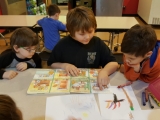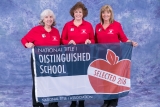-
Category 1
Selected in 2016
-
Grades: pre k - 4
School Setting: rural
Town Population: 312
Student Enrollment: 136
Student Demographics:
Black/African American: 0%
Teacher/Student Ratio: 1:16
White/Caucasian: 98%
Hispanic: 0%
Hawaiian/Pacific Islander: 0%
Asian: 0%
Native American: 0%
Other: 2%
% Reduced Lunch: 100%
% ELL Learners: 0%
Founded: 1940 -
PRINCIPAL:
Jeanne Gren -
CONTACT:
824 Simpson Road
Flemington, WV 26347
304-739-4749
jgren@k12.wv.us
Flemington Elementary School
Flemington, WV
Our core beliefs: We are family. We help each other learn and grow. With hard work, anything is possible!
- Describe specific programs in place to ensure that families are involved in the success of your school and students.
- Parent breakfasts certainly get involvement off to a happy start. But the support continues through our homeworks program. Every student and family is expected to read every night and/or complete a brief homework page. Families maintaining this throughout the year are rewarded with a day at the pool in May. We also encourage and expect summer reading and writing. Students who complete a reading log and journal have a special day of fun in the sun, complete with a huge spray from the community fire truck!
- Describe the most successful activity your school has initiated to strengthen ties to your community.
- Parent breakfasts are a strong tradition at Flemington Elementary and much beloved by parents and students alike. Once a year, each grade level invites their parents to come in and eat breakfast with their child. After eating together, the child introduces their parent(s) to their class. The Title I teacher explains a strategy or literacy skill appropriate for that grade level, and the classroom teacher talks about expectations and ways for parents to help at home. Some classes do a skit or song, and some play math or reading games. Parents in 3rd and 4th are also invited to the computer lab to learn about the standardized testing that occurs each spring and they get to try a practice test. Through the years, it really helps develop a sense of family.
- Describe your philosophy of school change or improvement.
-
Our philosophy is reflected in our core beliefs:
We are family.
We help each other learn and grow.
With hard work, anything is possible! - What are your school’s top two goals for the next year?
-
The official goals in our strategic plan focus on achievement. Students will maintain and improve their proficiency in reading and math.
Our professional goal as a school staff is collaborating to formalize curriculum maps and document effective strategies. - What is the single most important factor in the success of your school that others could replicate?
- The experience, dedication and persistence of our teachers are the foundation to our success. But most importantly, we think the size of our school forces a crucial level of accountability for students and teachers alike. With one class per grade level, the next year’s teacher knows where they came from. When students claim they “don’t know about capitalizing the first word in a sentence”, our teachers have been known to march the class back down to the kindergarten room and ask! Teacher discussions at recess have included informal curriculum mapping decisions, like “those kids have to know their addition facts before they get to my room!” Underlying the banter though, is our core beliefs: We are family. We help each other learn and grow. With hard work, anything is possible.
- Describe the program or initiative that has had the greatest positive effect on student achievement, including closing achievement or opportunity gaps, if applicable.
- Benchmark assessments provide a regular opportunity to mark progress. Teachers take time to conference with students about their growth over time. During assemblies and award programs, we emphasis the power and control students have to make themselves smarter. With hard work, anything is possible!
- Explain how Title I funds are used to support your improvement efforts.
- Title I funds support the salaries of our reading interventionist, part-time tutors and a Parent Involvement Coordinator . Professional development is another strong component, and the funds help give us time to talk as a Learning School. Instructional supplies are also important. Last year, every child brought home a book five different times throughout the year. In addition, they brought home between 15 and 20 self-chosen books for summer reading!
- Identify the critical professional development activities you use to improve teaching and student learning.
- As a small school, there is typically only one teacher per grade level. This ensures strong collaboration between grade levels. Teachers discuss curriculum and instructional strategies at lunch and recess. The past several years, we have worked to formalize this collaboration as a Learning School and meet twice a month after school. We set goals, monitor student progress and identify our own learning needs as a staff to meet those goals.
- Describe how data is used to improve student achievement and inform decision making.
- Benchmark assessments at all grade levels help teachers monitor progress and growth. Students take the Measures of Academic Progress by NWEA in reading and math three times a year. Students know their target and we celebrate their growth! Informal assessments occur more frequently and provide immediate and personal feedback. Classroom teachers, the Title I specialist and our tutors collaborate to identify, support and monitor students needing additional help.
- Describe your school culture and explain changes you’ve taken to improve it.
- As a small school with an experienced and dedicated staff, our school culture has always been strong and closely knit. Every teacher knows every child. The teachers have high expectations for their students AND for themselves. We believe that all students will learn and we will find a way to help them succeed.
Stats
-
Category 1
Selected in 2016
-
Grades: pre k - 4
School Setting: rural
Town Population: 312
Student Enrollment: 136
Student Demographics:
Black/African American: 0%
Teacher/Student Ratio: 1:16
White/Caucasian: 98%
Hispanic: 0%
Hawaiian/Pacific Islander: 0%
Asian: 0%
Native American: 0%
Other: 2%
% Reduced Lunch: 100%
% ELL Learners: 0%
Founded: 1940 -
PRINCIPAL:
Jeanne Gren -
CONTACT:
824 Simpson Road
Flemington, WV 26347
304-739-4749
jgren@k12.wv.us








